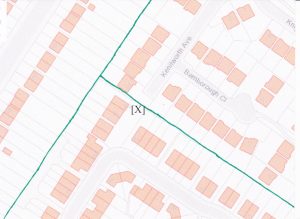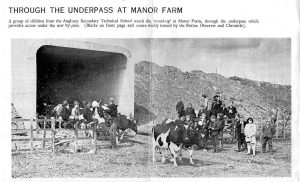Some Thoughts About RAF Tatenhill by An Airman.
One’s memory 59 years after events occurred is not entirely reliable, but here are some recollections about flying at RAF Tatenhill in 1944. A royal Canadian Air Force officer, I received pilot training in Canada on North American Harvards, flew Miles Masters at 17 AFU at RAF Watton, and converted to Mustangs at 41 OTU at RAF Hawarden (and nearby Poulton). After tactical/fighter operations on Mustangs with 170 Squadron RAF, I was posted to the Flying Instructor Course on Airspeed Oxfords at RAF Montrose. My first posting as a qualified instructor was to 21 (P) AFU (Pilot Advanced Flying Unit) at RAF Tatenhill, near Burton-on-Trent, in early May 1944.
Having been stationed at a number of airfields in England, it’s difficult to remember the particulars of any one of them. Tatenhill, called Cross Plains by the locals, was in a lovely rural setting. The officer’s quarters, which were in a one-storey building, were reasonably comfortable with two officers to a room. The rooms contained small coal stoves. The toilets and bath houses were in adjacent buildings. Close by was the Officers’ Mess. It had a main lounge with fireplace and a billiard table, a bar, a separate dining room, and a cloak room near the entrance. Its main shell was still standing when I last visited the site, although one had to step around cow dung to view it. We ate all our meals in the Mess when on base. Occasionally we had parties and dances there, but more often we went into town for entertainment. Not far from the officer’s mess was the Sergeants Mess.
I can’t remember much about the hangar line, which was probably quite standard. I recall there being a bicycle shop in one of the lean-to’s, which was a busy place because almost everyone had a bicycle.
(The pubs in the area were well patronized. The closest was the New Inn on the nearby intersection where several roads (five I think) met. We also tippled at the Acorn at Rough Hayes, the nearby Burnt Gate and the Bell in Anslow. Sometimes we attended dances in Anslow’s village hall.)
The AFU students had already graduated as pilots. Some had earned their wings on single-engine Harvard or Master aircraft; others had trained on twins, such as Cessna Cranes, Avro Ansons, and Oxfords. We instructed them on the twin-engine Oxford to prepare them for further operational training on bomber aircraft.
For pilots trained under the British Commonwealth Air Training Plan (BCATP) in Canada and who had not yet experienced flying in the UK, AFU provided a useful orientation to flying over England’s terrain. Until one got used to it, navigating over this congested, confusing patchwork was a challenge. Nothing in the tangle of roads and railways ran in a straight line, and visibility was often reduced by industrial haze – so different from flying over Canada’s open spaces, where the roads, railways and farm fences ran straight and the skies were more often clear.
To digress for a moment, the BCATP under whose auspices most of us learned to fly was the greatest undertaking of its kind before or since. Altogether the plan produced 131,553 aircrew, of which 72,835 were RCAF. Other trainees were from the Royal Air Force (including Allied nationals, such as those from South Africa and Trinidad), Royal Australian Air Force and Royal New Zealand Air Force. Of the RCAF trainees, 25,747 were pilots, 12,855 navigators, 6,659 air bombers, 12,744 wireless air gunners, 12,917 air gunners and 1,913 flight engineers.
Fondly called the “Ox-box”, the Oxford had a reputation for being rather tricky to fly and it was said that having mastered it students would be well equipped to handle more powerful aircraft at Operational Training Units, which was the next step in their bomber training. The Oxford was powered by two 355h.p. Armstrong-Siddeley Cheetah radial engines. For most Canadian trained pilots, the Oxford’s instrumentation and controls took some getting used to. It had British turn and bank needles, instead of the American “needle and ball” display. Engine boost was calibrated in pounds rather than inches of mercury. Instead of hydraulic brakes operated by toe pressure on the rudder pedals, the Oxford had air brakes operated by a device on the control column.
A stout rope was fastened along the port side of the Oxford’s cabin, from the cockpit to the exit door. The Oxford’s spin was very flat and I heard that there had been incidents where people trying to abandon the aircraft had been thrown to the rear of the cabin by centrifugal force and trapped there, unable to reach the door. The rope gave one something to hang on to in these circumstances. My first flight at Tatenhill was on May 4th 1944. AFU instruction followed standard RAF sequences.
The hours available for night flying were greatly increased by means of what was called day/night training using sodium flares. This clever innovation made it possible to practise night flying circuits during daylight hours. High intensity sodium lamps along each side of the runway simulated a night flare path. Student pilots wore goggles fitted with dark lenses of different intensities, which could create the illusion of various night conditions from bright moonlight to complete darkness. The instructor, who didn’t wear the goggles, had a normal daylight view. It was a safe and effective way of doubling the night training capacity of the airfield.
The night flying curriculum included cross-country trips, my most vivid memory of which is the gorgeous colours of the sky and clouds. We’d take off just after dark. At cruising altitude the sun would just be setting, sometimes followed by the moon rising. Usually there was a blanket of stratus cloud to penetrate. Breaking out above it, we were often bathed in a spectacular panorama of colour, muted shades of red, orange, blue and mauve, an exquisite kaleidoscope of ever-changing pastels too beautiful to describe. On some of these night cross-country exercises we carried a wireless operator who maintained contact with base and provided bearings and homings to assist with navigation.
To help friendly forces navigate at night in the UK, the landscape was dotted with beacon lights that flashed Morse code identifiers that changed nightly. The beacons were of two types: Pundits and Occults. Pundits flashed red lights and identified geographical positions; Occults were white and were located near aerodromes.
Another useful aid was the DREM system (I can’t remember what the letters stood for), which helped night flying aircraft to land in bad weather. If you needed assistance you flew a certain pattern around the aerodrome’s Occult beacon and flashed an assigned code. Soon a large circle of yellow lights, about four miles in diameter, appeared on the ground, the lights about 200 yards apart. You flew around the circle until you saw a funnel of lights leading toward its centre. At the narrow end of the funnel was the runway. To minimize the chance of enemy aircraft seeing the DREM display, the lights behind you were extinguished as soon as you passed over them. Once in the funnel, you could see the lighted runway. A Glide Path Indicator was positioned on the left side of the runway button. It consisted of a vertical display of shielded coloured lights: amber if you were too high, green if you were on the correct glide path, and red if you were too low.
One day I was surprised at being assigned a student named Wing Commander James who’d already earned an Air Force Cross. It wasn’t just his senior rank that surprised me. I recognized him as the Squadron Leader who’d commanded my Flight when I was an ab-initio student pilot at SFTS in Canada. Now it was my turn to put him through the ropes!
Circling to land at Tatenhill on the afternoon of June 5th 1944, I witnessed a tragedy – an aircraft diving toward the ground in a tail spin. It was a Miles Martinet from Lichfield. It crashed and burned two miles northeast of Tatenhill, killing the two pilots, both Australians.
Personally, I’d lived a charmed life so far, having survived ops, as well as a head-on collision of two Mustangs at RAF Odiham. My luck still held when an incident occurred at Tatenhill that could have left me a cripple. During a training flight, a piece of metal broke off from the tip of a propeller blade. With a loud bang it shot through the nose section of the Oxford, passing about an inch above my ankle!
Hanbury Dump Explosion. At 1100 hrs on Nov 27th 1944 I was sitting on a toilet in the hangar area at Tatenhill when suddenly the ground shook and there was a horrendous roar. My first thought was that one of the new German V2 rockets must have landed nearby. It was far worse than that. In one brief moment near the village of Hanbury, five miles from our airfield, 1,500 two-ton “block-busters”, those huge town-smashing bombs that were dropped on Germany by our Lancaster bombers, that were stored in disused mine-workings, had detonated, together with hundreds of smaller bombs. It was the biggest single explosion of the war in the West. In this one fantastic bang, there had gone up nearly ten times the tonnage dropped on Coventry during its famous hours-long blitz. The explosion blasted a giant crater in the pastoral landscape a third of a mile long and a quarter of a mile wide. I flew over it next day to have a look. It wiped out of existence two complete farms and killed over 60 people and scores of farm animals. Buildings in Burton-on-Trent, five miles away were damaged. (Parts of this description are quoted from a newspaper source, which I’ve unfortunately mislaid.)
An important part of the AFU course was Beam Approach training. At the end of November I began instructing at 1515 BAT (Beam Approach Training) Flight at Poulton, near Chester, which was a unit of 21(P)AFU.










